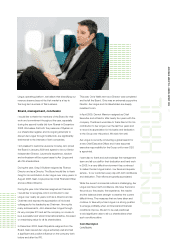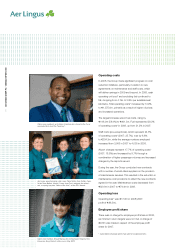Aer Lingus 2008 Annual Report Download - page 17
Download and view the complete annual report
Please find page 17 of the 2008 Aer Lingus annual report below. You can navigate through the pages in the report by either clicking on the pages listed below, or by using the keyword search tool below to find specific information within the annual report.
AER LINGUS GROUP PLC - ANNUAL REPORT 2008
15
3.5
4.0
4.5
5.0
5.5
6.0
6.5
7.0
7.5
8.0
8.5
Aer Lingus fleet 2008
4.15 litres /100 RPK
1991 1993 1995 1997 1999 2001 2003 2005 2007
49% reduction
since 1991
and local air quality, and our modern fleet contributes to
efficiencies in these emissions.
30% of our ground equipment uses electric power, which
helps reduce our ground emissions. Where operations
allow, consideration is given to the use of electric power
rather than power which generates emissions.
Figure 2 shows the significant reduction in average
specific fuel consumption over the past two decades –
a drop of 49% since 1991.
Noise: Aer Lingus’ aircraft are amongst the quietest in the
industry due to their low average age. Aer Lingus generally
does not operate flights late at night when noise is of the
greatest concern. As airports levy “noise charges”, Aer
Lingus’ efforts to reduce noise (e.g. use of ground power
instead of Auxiliary Power Units) can also generate cost
efficiencies. Continuous Descent Approaches (CDAs) are
now performed wherever possible. This involves using a
continuous steady descent rather than following a number
of short descents. The CDA flight path is generally higher,
thereby reducing noise impacts and there is also a beneficial
impact on emissions. Aer Lingus fully complies with all
international and national regulations and continues to focus
on developing and implementing low noise procedures.
Waste management: As with all airlines, Aer Lingus
must store and/or handle potentially hazardous waste
as a result of its operations (e.g. solid/liquid waste from
maintenance operations). These operations are subject to
detailed legislation and regulation. All staff involved in these
operations receive appropriate training and Aer Lingus
ensures that processes applied both internally and, by third
parties engaged to treat such waste, are in line with best
practice. Non-hazardous waste from aircraft is also subject
to controls and licensing. Aer Lingus continues to achieve
reductions in catering waste due to the “buy on board”
products whereby food is purchased based on individual
passenger needs. Aer Lingus complies fully with the Waste
Electrical and Electronic Equipment Directive (WEEE)
through a programme to segregate these items from the
waste process and implemented this programme before
it was required by regulations.
Average specific fuel consumption (litres per 100 revenue passenger kilometres)
Fig 2
Pictured: Former Aer Lingus CEO, Dermot Mannion and members of the Aer Lingus
Sales Team celebrate the airline’s award “Best Airline to Europe” by the Irish Travel
Trade News Awards
























